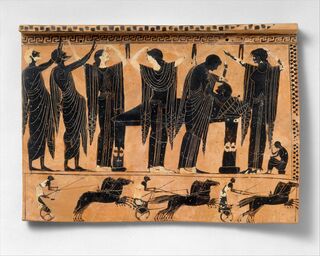Coronavirus Disease 2019
The Raging Cytokine Storm
The havoc wrought by an immune system gone rogue.
Posted May 30, 2020 Reviewed by Gary Drevitch

“But for him it was his last afternoon as himself…The provinces of his body revolted …” (W.H. Auden, from his collection, Another Time, 1940)
Twentieth-century British-American poet W.H. Auden captures the essence of a change just before death in this elegy, In Memory of W.B. Yeats. “The day of his death was a dark cold day,” is Auden’s refrain. As the death toll in the U.S. alone from COVID-19 has topped 100,000 and continues to rise throughout much of the world, many have experienced the sudden turn for the worse of their loved ones—how the provinces of their bodies seem literally to have revolted.

Though there is still so much we don’t know about SARS-CoV2, clinicians are beginning to appreciate the role of the body’s immune system in creating this havoc. What do we know about an immune system that has gone rogue and the phenomenon metaphorically called cytokine storm?
Cytokines are small proteins—“polypeptide mediators”—that are the basis of our body’s innate immunity. (Clark and Vissel, Seminars in Immunopathology, 2017) Secreted by cells to facilitate intercellular signals and communication, (D’Elia et al, Clinical and Vaccine Immunology, 2013) they can elicit different responses, depending both on the type of cytokine and the target cell. (Tisoncik et al, Microbiology and Molecular Biology Reviews, 2012) At lower concentrations, they have many physiological functions, including maintaining homeostasis and mitochondrial functioning. The word cytokine, though, has become a generic term. (Clark and Vissel, 2017) The major types include interferons, involved in the regulation of innate immunity; interleukins, (Il-1 to Il-37) involved in the growth and differentiation of leukocytes; chemokines, of which there are at least 44, involved in chemotaxis (i.e., movement in response to a chemical stimulus); and tumor necrosis factor-alpha (TNF-alpha), the best known and considered the “central cytokine” released in response to viral infections such as influenza and dengue fever. (Tisoncik et al, 2012) Once released, cytokines set in motion the body’s immune system and recruit neutrophils, macrophages, and lymphocytes. Many, but not all, cytokines are considered pro-inflammatory; Il-10 is one example of an anti-inflammatory cytokine. (Tisoncik et al, 2012)

There were references to medical “storms," (e.g., asthmatic storm; rheumatic storm), i.e., "paroxysms," in a late 19th-century medical textbook (Oxford English Dictionary, storm), and the term thyroid storm, the potentially deadly clinical syndrome of "acute hyperthyroidism," (Root, Transactions of the American Clinical and Climatological Association, 1935) has been used at least since the 1930s. The description, though, that has come to be associated with cytokine storm was first reported as a graft-versus-host disease reaction in the early 1990s in which T lymphocytes in the donor graft “recognized antigenic disparities” between donor and recipient, (Antin and Ferrara, Blood, 1992; Ferrara, Current Opinion in Immunology, 1993) resulting in a sudden, "chaotic" (Clark and Vissel, 2017) release of inflammatory cytokines that led to “unbridled inflammation” within tissues and organs (Yiu et al, PLOS ONE, 2012).
It has been suggested that the term cytokine storm itself was perhaps modeled on Desert Storm, the U.S.-led invasion of Iraq in 1991 that was precipitated by Iraq’s aggression toward Kuwait. (Clark, Immunology and Cell Biology, 2007; England et al, Blood Reviews, 2020) Though the first use of cytokine storm in the context of infectious disease occurred in relation to influenza in 2003, researchers, through animal models, now believe that cytokine storm was likely responsible for the severity of the 1918 Spanish Flu pandemic, by creating “an aberrant, dysregulated pro-inflammatory response.”(Short et al, Frontiers in Cellular and Infection Microbiology, 2018) Cytokine storm has been implicated in diseases such as malaria, as well as yellow fever, hepatitis B, Marburg, Ebola, the 2005 H1N1 influenza virus, and now COVID-19 (Zhang et al, Clinical Immunology, 2020), among others. (Clark, 2007; Tisoncik et al, 2012) Intriguingly, cytokine storms have also been implicated in acute and chronic neuro-degenerative states, including delirium, post-traumatic brain disorders, post-stroke injury, and even Alzheimer's disease whereby TNF-alpha, rather than beta amyloid, is speculated to be the "key to its pathogenesis." (Clark and Vissel, 2017)

Further, cytokine storm has been associated with sepsis, septic shock, and even toxic responses to medication. One of the most devastating examples occurred in Great Britain in a Phase I trial in 2006 in which six healthy volunteers were given a humanized monoclonal antibody. Though there was considerable variation in the responses among the six subjects, the majority experienced a “catastrophic reaction,” due to cytokine storm, from this drug, (Pang et al, Immunology and Cell Biology, 2007) with multi-organ failure, including to the lungs and kidneys, that required mechanical ventilation and dialysis. (Yiu et al, 2012)

An actual consensus definition of cytokine storm, sometimes referred to as the cytokine release syndrome, (Moore and June, Science, 2020) though, even in the context of COVID-19, is lacking and its overwhelming outpouring of inflammatory cytokines has become an “umbrella term” (England et al, 2020) for both infectious and non-infectious (e.g. severe burns or trauma) conditions. (Sordillo and Helson, In Vivo, 2015; Tisoncik et al, 2012) Note, incidentally, how those who write about cytokine storm tend to wax poetic themselves and use terms like "umbrella," "perfect storm" (Aleksandrova et al, Clinical Chemistry, 2018; Pang et al, 2007); "weathering the storm," (England et al, 2020); "in the eye of the storm" (Tisoncik et al, 2012); and the "meteorology of cytokine storms" (Clark and Vissel, 2017).
With infectious disease, researchers have come to appreciate that the severity of most infectious disease is less the result of an actual pathogen and more likely the result of an “over-exuberant innate immune response.” (Clark and Vissel, 2017) Clinically, there is systemic inflammation due to the release of many cytokines (e.g. IL-6 and TNF-alpha, among others) that may have started locally and spread, leading to multiple organ failure and ultimately death. (Zhang et al, 2020) Inflammatory markers tend to worsen between 7 to 10 days after the beginning of illness. (England et al, 2020) Levels of Il-6, for example, can be "up-regulated" to more than 1000 times resting level (D'Elia et al, 2013).
Measurements for monitoring "cytokine profiles" during cytokine storm, though, have not yet been standardized clinically and remain mostly limited to research settings. (England et al, 2020) In hospital settings, the "pattern of inflammatory markers" may be more important than focusing on a specific value, but clinicians also note extreme abnormalities in the iron storage protein ferritin and C-reactive protein, a marker of inflammation found in blood plasma, (England et al, 2020) as well as an unusually low lymphocyte count. (Chen et al, The Journal of Clinical Investigation, 2019.)
Further, those treating patients with severe COVID-19 have noticed abnormal coagulation and an increased risk of venous thrombo-embolism (Poor et al, medRxiv, preprint, 2020), with increased D-dimers, i.e., small protein fragments seen in the blood after a blood clot has been broken up--all consistent with evidence of pulmonary vascular disease. (Poor et al, 2020)

Bottom Line: Cytokine storm is a poetic term for a potentially deadly condition, manifested by an immune system gone rogue, i.e., as if the "provinces of the body" have revolted. It is now thought to have been responsible for the severity of the 1918 Spanish flu pandemic that killed millions worldwide. More recently, it has also been associated with infectious diseases, including COVID-19, Ebola, and many other viruses, but also with non-infectious conditions, such as reactions to medications, trauma, delirium, and even neurodegenerative disorders such as Alzheimer's disease. Not all patients who have severe COVID-19 necessarily develop cytokine storm, and we do not yet completely understand why some patients are more susceptible than others. Most likely, genetic variations are involved. In my next blog, I address the specific vulnerability of those COVID-19 patients who are obese. Regardless of why, we would all agree that it is, indeed, a dark cold day when a cherished one dies.
Note: Special thanks to Barry S. Coller, MD, Physician-in-Chief, The Rockefeller University Hospital, for calling my attention to the long history of the use of the term thyroid storm, as well as to evidence of pulmonary vascular disease in some seriously ill COVID-19 patients.




